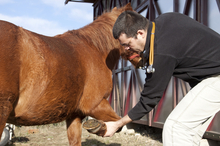Results from the Blue Cross National Equine Health Survey (NEHS), have revealed lameness as the most common syndrome affecting the UK's horses and ponies. The 2013 survey attracted a 21% increase in responses from across the sector, indicating that more people than ever are keen to safeguard the future health and welfare of their horses.

Horse lameness exam by a veterinarian
Results from the Blue Cross National Equine Health Survey (NEHS), have revealed lameness as the most common syndrome affecting the UK's horses and ponies.
The data will be released to equine and veterinary colleges and universities to be used as primary source material.
Run annually by Blue Cross, in partnership with the British Equine Veterinary Association (BEVA), the survey revealed that 18.6% of horses were suffering with lameness issues, predominantly degenerative joint disease. This represents a 5% increase on 2012 figures, which placed lameness as the second most recorded condition below skin disease.
The key results of this year's survey substantiate the findings of previous surveys, confirming the reliability and value of the data received. The top five findings are:
- Lameness (18.6%; 13.8% in NEHS 2010-2012), with degenerative joint disease was the most prevalent cause of lameness (14.8% of horses) and foot lameness recorded in 3.8% of cases.
- Skin disease (14.6%; 15.2% in NEHS 2010-2012). Sarcoids were again a prevalent tumour ((2.8%; 3.25% in NEHS 2010-12), reinforcing previous NEHS surveys and the published data.
- Overweight (7.8%; 7.5% in NEHS 2010 - 2012) with most horses (41%) being recorded as ideal/normal weight and 4.1% recorded as being underweight. This is a consistent trend in NEHS surveys, which is different from previously published data.
- Back problems (5%; 3% in NEHS 2010 - 2012).
Respiratory disease (5%; the same prevalence as in NEHS 2010-2012). Allergic respiratory disease was reported more frequently (4.2%; 3.6% in NEHS 2010-12) more frequently recorded than infectious respiratory disease (0.3%; 0.5% in NEHS 2010-12).
This year a new question on vaccinations revealed that 95% of horses were up-to-date with flu and tetanus jabs. This figure is much higher than the 65% identified by Blue Cross on assessment of the horses and ponies taken in by the charity during 2012 and is also far higher than pharmaceutical data that suggests as few as 45% are vaccinated.
"It is excellent that nearly all who completed the NEHS survey were also keeping their horse's flu vaccinations up to date," said Josh Slater, Professor of Equine Clinical Studies at The Royal Veterinary College, who is responsible for analysing the NEHS results.
"However the lower estimates of flu vaccination rates from other research remain concerning. With a mobile virus like flu any horse can be susceptible and herd immunity is vitally important in order to prevent the risk of serious outbreaks."
Gemma Taylor, Blue Cross education officer concludes: "The significant increase in participants and the consistency of NEHS results over the past three years confirms the relevance of our work to the equestrian industry.
We are particularly excited by the fact that colleges are now recognising the value of NEHS data, not only as a guide to study topics but also as important source material for students."
Supported by Zoetis UK Ltd (formerly Pfizer Animal Health), NEHS was introduced in 2010 and is now an annual fixture. It is conducted as an online snapshot survey of common health issues in horses, communicated directly by horse owners themselves. The results help establish benchmarks for equine health and disease in the UK and define priorities for future research, training and education.
